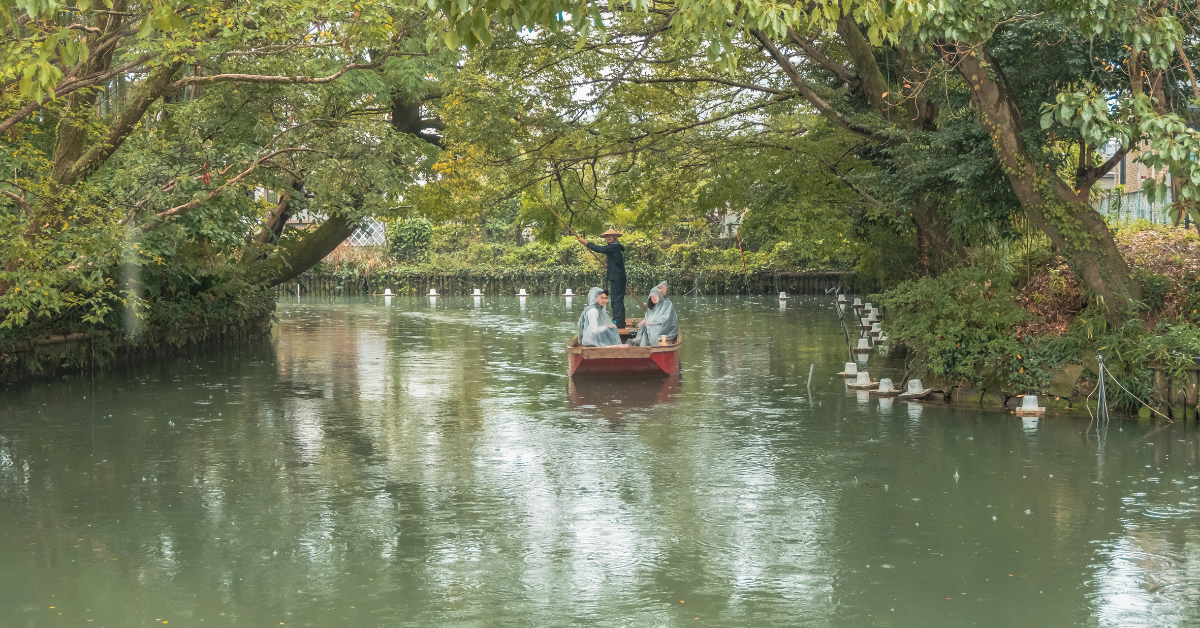Yanagawa River Cruising is a journey through Fukuoka’s historic waterways on wooden boats called “donko-bune.” For Japanese people, it feels nostalgic and healing, while for foreigners, it offers cultural freshness. The charm lies in the fact that the seasonal scenery and the boatman’s songs create a unique travel experience.
Basic Information about Yanagawa River Cruising
Yanagawa City is a historic water town in northern Kyushu, where waterways built during the Edo period still remain. Once a thriving castle town, the canals were originally constructed for defense and logistics, but today they serve as a major tourist attraction.
The donko-bune are propelled only by a single pole without using engines, so passengers can hear the sound of water and birds. The cruise lasts about 60 to 70 minutes. As the departure and arrival points are different, many visitors enjoy strolling and dining in the surrounding area after the cruise.
| Item | Details |
|---|---|
| Departure Point | Boat docks in Yanagawa City |
| Duration | About 60–70 minutes |
| Price | Around 1,500 yen for adults, 800 yen for children |
| Boat Features | Wooden donko-bune, capacity around 10 people |
| Highlights | White-walled townscape, willow trees, stone walls, bridges |
Japanese Impressions of the Cruise’s Charm
What Japanese visitors find most memorable is “the boatman’s songs.” These are traditional folk songs of the region, sometimes mixed with humorous storytelling that entertains passengers. Many say, “The warm voice healed me” or “The songs deepened the travel atmosphere.”
Another major attraction is the changing scenery with the four seasons. Cherry blossoms in spring, lush green willows in summer, colorful leaves in autumn, and kotatsu boats in winter. Japanese often say, “It feels completely different every season,” and many return multiple times to enjoy the varied landscapes.
Seasonal Highlights
The cruise offers different charms throughout the year, and Japanese visitors especially appreciate the seasonal scenery.
| Season | Highlights | Japanese Impressions |
|---|---|---|
| Spring | Cherry blossoms along the river | “The reflection of the blossoms on the water is magical.” |
| Summer | Shade of willow trees | “The green tunnel makes me forget the heat.” |
| Autumn | Red and yellow foliage | “The colorful scenery is breathtaking.” |
| Winter | Kotatsu boats with heated tables | “It’s warm and comfortable despite the cold.” |
Every season offers a new discovery, which is why many Japanese invite family or friends and return repeatedly.
Why Foreigners Love It and Japanese Perspectives
For foreigners, Yanagawa River Cruising is a microcosm of Japanese culture where one can experience something extraordinary. With no engine noise, the ride is reminiscent of gondolas in Europe but infused with unique Japanese history and atmosphere.
Japanese impressions can be summarized as follows:
| Japanese Impressions | Details |
|---|---|
| Relaxing | The gentle rocking makes time stand still |
| Songs are enjoyable | The boatman’s personality and voice are heartwarming |
| Rich in seasons | Different charm in each season |
| Family-friendly | Safe for both children and elderly |
| Photogenic | Perfect for capturing travel memories |
These impressions represent universal values that foreigners can easily relate to, making them a gateway to understanding Japanese culture.
Combining River Cruising with Local Food
Another highlight is combining the cruise with local food. Yanagawa is famous for “Unagi Seiro-mushi” (steamed eel over rice). The fluffy eel, sweet-savory sauce, and rice steamed together create a dish that Japanese often describe as “a perfect reward after the boat ride.”
| Specialty Dish | Features | Japanese Impressions |
|---|---|---|
| Unagi Seiro-mushi | Steamed in a wooden steamer | “Rich, fragrant, and luxurious.” |
| Yanagawa Nabe | Loach cooked with egg | “A homely and traditional flavor.” |
| River Fish Dishes | Made with local river fish | “Simple and nostalgic.” |
Being able to enjoy both sightseeing and cuisine together is one reason why Japanese rate Yanagawa so highly. For foreigners too, tasting local specialties after the cruise greatly enhances satisfaction.
Extra Efforts to Enhance the Experience
The cruise operators make efforts to ensure that visitors have a comfortable time.
| Improvement | Description | Japanese Feedback |
|---|---|---|
| Roofed Boats | Protection from rain | “I enjoyed it without worrying about the weather.” |
| Kotatsu Boats in Winter | Heated tables inside the boat | “So cozy and warm, it surprised me.” |
| Multilingual Pamphlets | Information in foreign languages | “My foreign friend felt comfortable joining.” |
| Onboard Photography | Staff take commemorative photos | “It was nice to take home memories.” |
Not only the experience itself but also these thoughtful services greatly influence positive impressions, enhancing Yanagawa’s appeal as a tourist destination.
Conclusion
Yanagawa River Cruising is a journey of nostalgia and healing for Japanese people and a fresh cultural discovery for foreign visitors. The boatman’s songs, seasonal scenery, historic townscape, and local cuisine combine to create unforgettable memories.
The essence of tourism lies in experiences unique to that place. Yanagawa River Cruising is a perfect example, and it is strongly recommended for foreign travelers as a uniquely Japanese activity. The view from the water is more than just sightseeing—it weaves a story that stays in the heart.






